reset MERCEDES-BENZ SPRINTER 2011 MY11 Operator’s Manual
[x] Cancel search | Manufacturer: MERCEDES-BENZ, Model Year: 2011, Model line: SPRINTER, Model: MERCEDES-BENZ SPRINTER 2011Pages: 292, PDF Size: 6.75 MB
Page 14 of 292
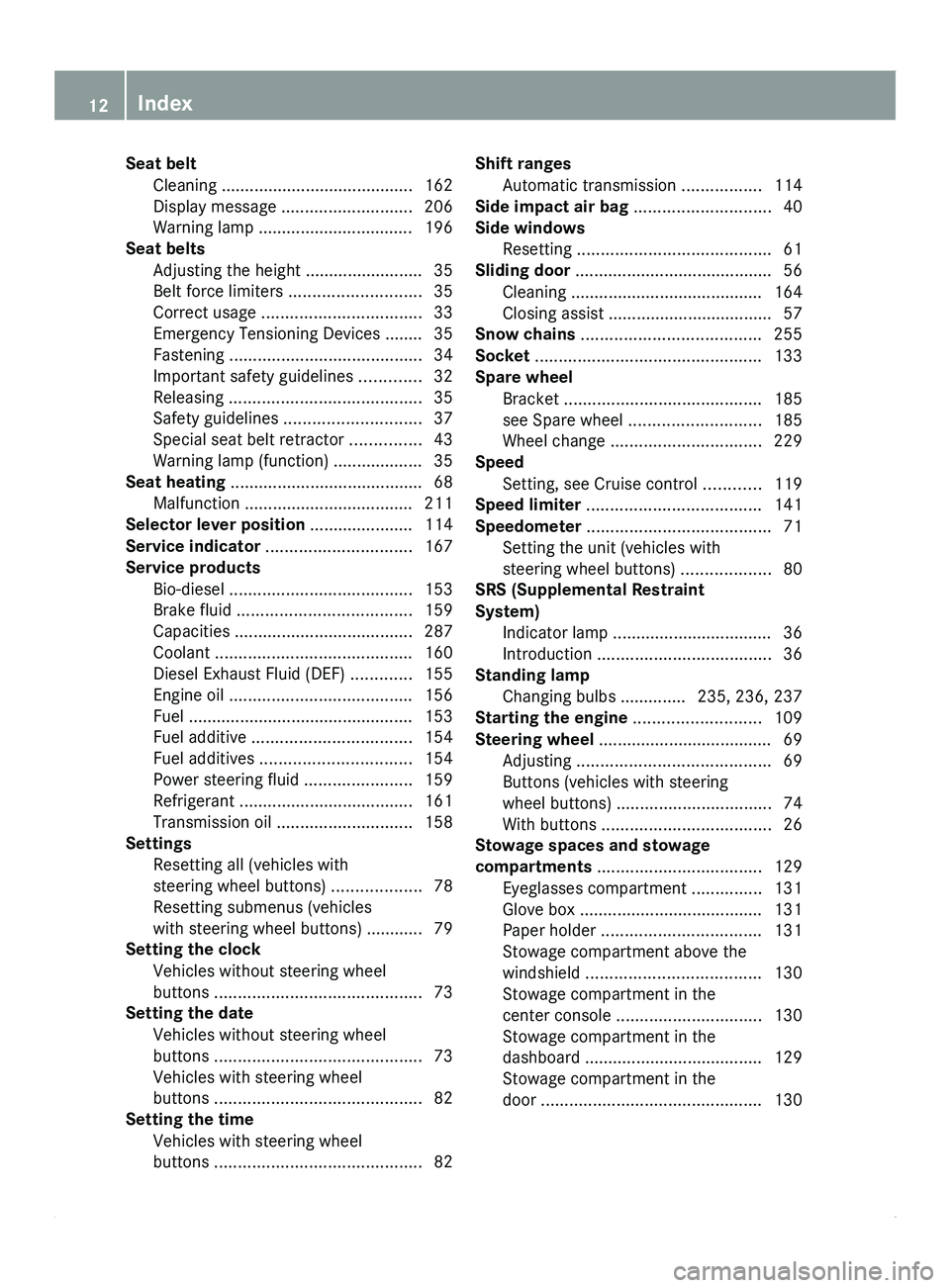
Seat belt
Cleaning ......................................... 162Display message ............................ 206
Warning lamp .................................
196
Seat belts
Adjusting the height ......................... 35
Belt force limiters ............................ 35
Correct usage .................................. 33
Emergency Tensioning Devices ........ 35
Fastening ......................................... 34
Important safety guidelines .............32
Releasing ......................................... 35
Safety guidelines ............................. 37
Special seat belt retractor ............... 43
Warning lamp (function) ................... 35
Seat heating ......................................... 68
Malfunction .................................... 211
Selector lever position ...................... 114
Service indicator ............................... 167
Service products Bio-diesel ....................................... 153
Brake fluid ..................................... 159
Capacities ...................................... 287
Coolant .......................................... 160
Diesel Exhaust Fluid (DEF) ............. 155
Engine oil ....................................... 156
Fuel ................................................ 153
Fuel additive .................................. 154
Fuel additives ................................ 154
Power steering fluid ....................... 159
Refrigerant ..................................... 161
Transmission oil ............................. 158
Settings
Resetting all (vehicles with
steering wheel buttons) ................... 78
Resetting submenus (vehicles
with steering wheel buttons) ............ 79
Setting the clock
Vehicles without steering wheel
buttons ............................................ 73
Setting the date
Vehicles without steering wheel
buttons ............................................ 73
Vehicles with steering wheel
buttons ............................................ 82
Setting the time
Vehicles with steering wheel
buttons ............................................ 82Shift ranges
Automatic transmission .................114
Side impact air bag
.............................40
Side windows Resetting ......................................... 61
Sliding door .......................................... 56
Cleaning ......................................... 164
Closing assist ................................... 57
Snow chains ...................................... 255
Socket ................................................ 133
Spare wheel Bracket .......................................... 185
see Spare wheel ............................ 185
Wheel change ................................ 229
Speed
Setting, see Cruise control ............ 119
Speed limiter ..................................... 141
Speedometer ....................................... 71
Setting the unit (vehicles with
steering wheel buttons) ................... 80
SRS (Supplemental Restraint
System)
Indicator lamp .................................. 36
Introduction ..................................... 36
Standing lamp
Changing bulbs .............. 235, 236, 237
Starting the engine ........................... 109
Steering wheel ..................................... 69
Adjusting ......................................... 69
Buttons (vehicles with steering
wheel buttons) ................................. 74
With buttons .................................... 26
Stowage spaces and stowage
compartments ................................... 129
Eyeglasses compartment ............... 131
Glove box ....................................... 131
Paper holder .................................. 131
Stowage compartment above the
windshield ..................................... 130
Stowage compartment in the
center console ............................... 130
Stowage compartment in the
dashboard ...................................... 129
Stowage compartment in the
door ............................................... 13012
Index
Page 16 of 292
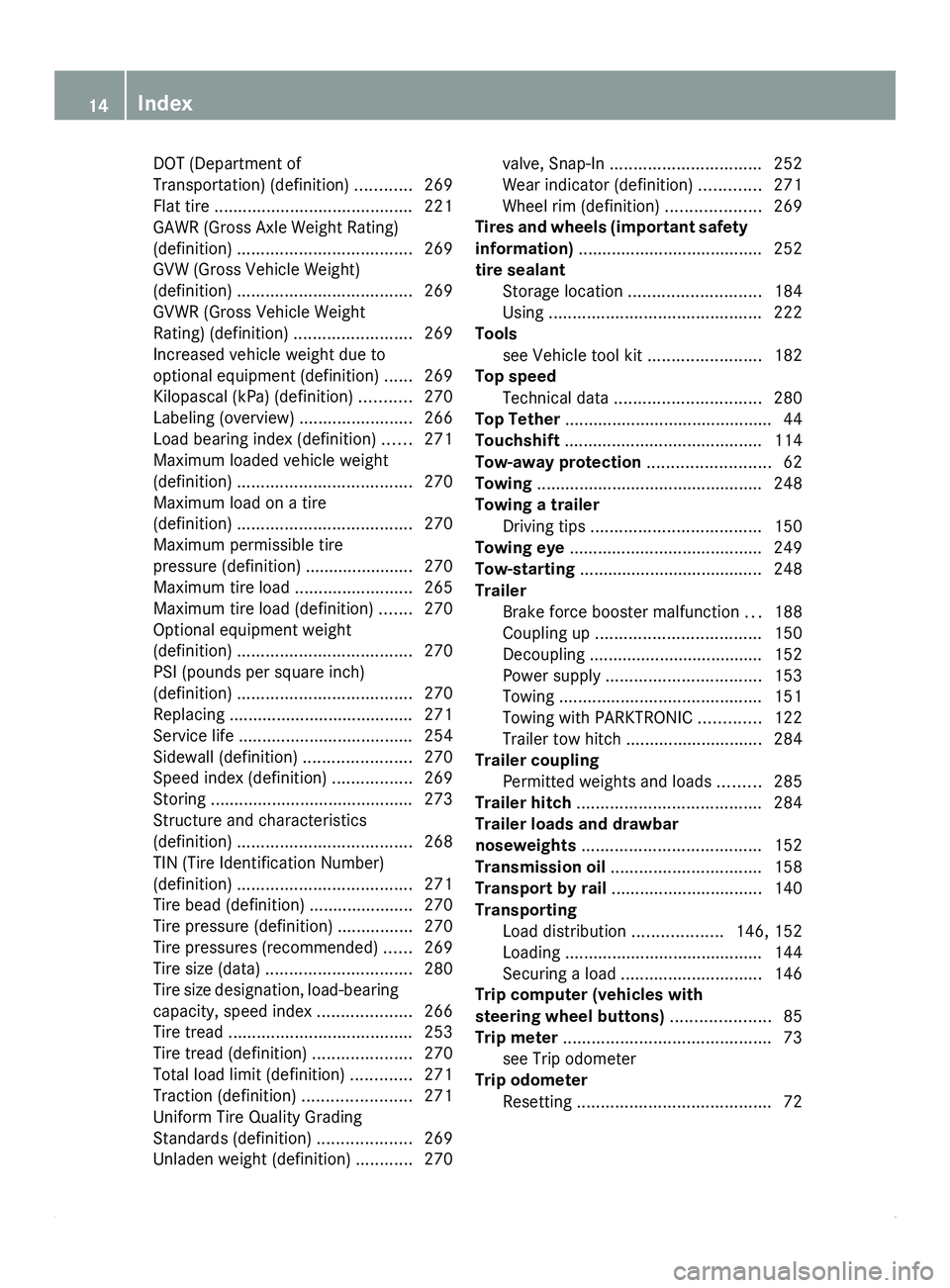
DOT (Department of
Transportation) (definition) ............
269
Flat tire .......................................... 221
GAWR (Gross Axle
Weight Rating)
(definition) ..................................... 269
GVW (Gross Vehicle Weight)
(definition) ..................................... 269
GVWR (Gross Vehicle Weight
Rating) (definition) .........................269
Increased vehicle weight due to
optional equipment (definition) ...... 269
Kilopascal (kPa) (definition) ........... 270
Labeling (overview) ........................ 266
Load bearing index (definition) ...... 271
Maximum loaded vehicle weight
(definition) ..................................... 270
Maximum load on a tire
(definition) ..................................... 270
Maximum permissible tire
pressure (definition) ....................... 270
Maximum tire load ......................... 265
Maximum tire load (definition) .......270
Optional equipment weight
(definition) ..................................... 270
PSI (pounds per square inch)
(definition) ..................................... 270
Replacing ....................................... 271
Service life ..................................... 254
Sidewall (definition) .......................270
Speed index (definition) ................. 269
Storing ........................................... 273
Structure and characteristics
(definition) ..................................... 268
TIN (Tire Identification Number)
(definition) ..................................... 271
Tire bead (definition) ......................270
Tire pressure (definition) ................ 270
Tire pressures (recommended) ...... 269
Tire size (data) ............................... 280
Tire size designation, load-bearing
capacity, speed index .................... 266
Tire tread ....................................... 253
Tire tread (definition) .....................270
Total load limit (definition) ............. 271
Traction (definition) ....................... 271
Uniform Tire Quality Grading
Standards (definition) .................... 269
Unladen weight (definition) ............ 270valve, Snap-In ................................
252
Wear indicator (definition) .............271
Wheel rim (definition) .................... 269
Tires
and wheels (important safety
information) ....................................... 252
tire sealant Storage location ............................ 184
Using ............................................. 222
Tools
see Vehicle tool kit ........................ 182
Top speed
Technical data ............................... 280
Top Tether ............................................ 44
Touchshift .......................................... 114
Tow-away protection .......................... 62
Towing ................................................ 248
Towing a trailer Driving tips .................................... 150
Towing eye ......................................... 249
Tow-starting ....................................... 248
Trailer Brake force booster malfunction ... 188
Coupling up ................................... 150
Decoupling ..................................... 152
Power supply ................................. 153
Towing ........................................... 151
Towing with PARKTRONIC .............122
Trailer tow hitch ............................. 284
Trailer coupling
Permitted weights and loads ......... 285
Trailer hitch ....................................... 284
Trailer loads and drawbar
noseweights ...................................... 152
Transmission oil ................................ 158
Transport by rail ................................ 140
Transporting Load distribution ...................146, 152
Loading .......................................... 144
Securing a load .............................. 146
Trip computer (vehicles with
steering wheel buttons) .....................85
Trip meter ............................................ 73
see Trip odometer
Trip odometer
Resetting ......................................... 7214
Index
Page 26 of 292
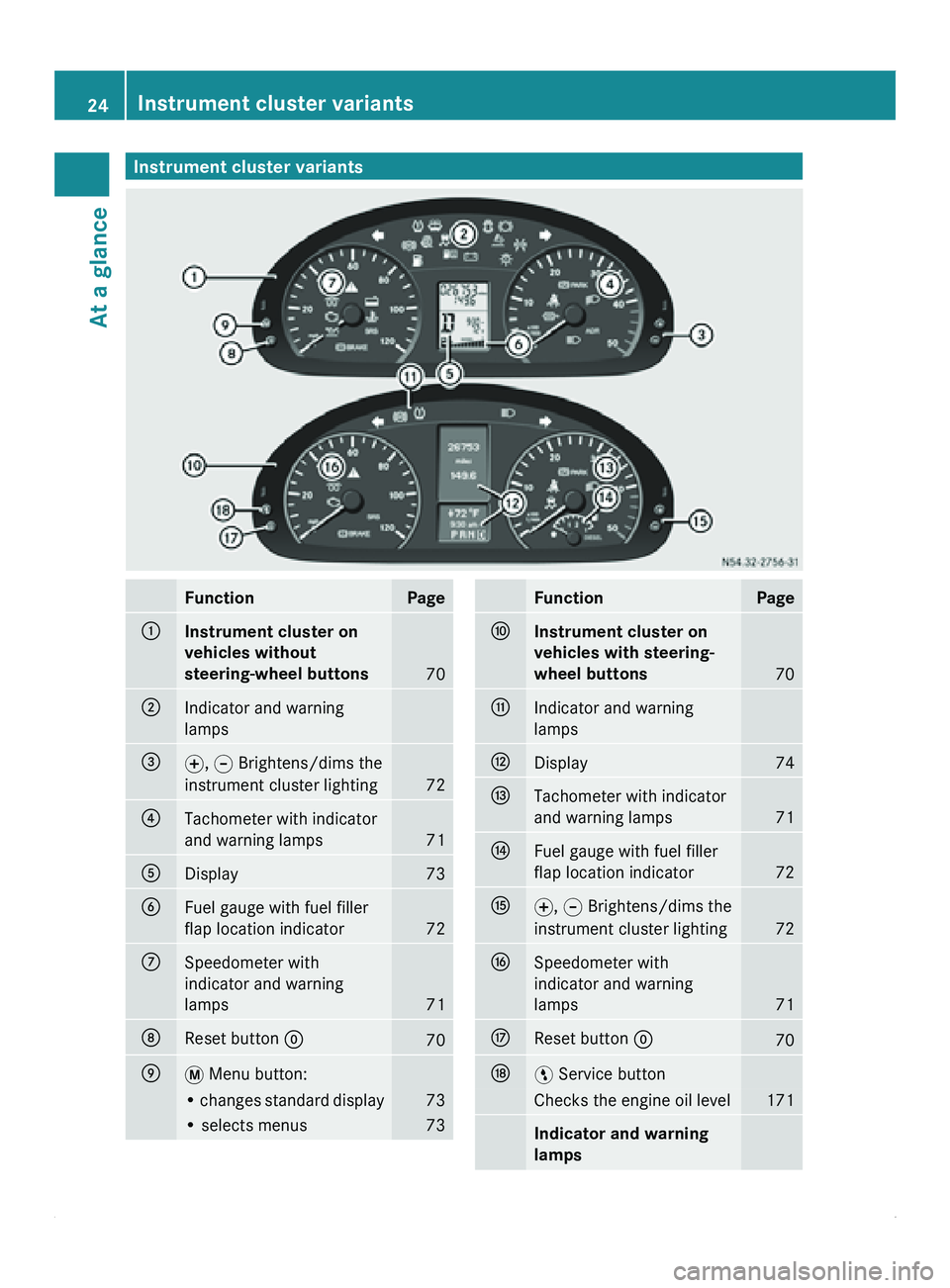
Instrument cluster variants
Function Page
0046
Instrument cluster on
vehicles without
steering-wheel buttons
70
0047
Indicator and warning
lamps
008A
0069, 006A Brightens/dims the
instrument cluster lighting 72
0088
Tachometer with indicator
and warning lamps
71
0086
Display 73
0087
Fuel gauge with fuel filler
flap location indicator
72
006E
Speedometer with
indicator and warning
lamps
71
006F
Reset button 0048
70
0070
007B Menu button:
• changes standard display 73
• selects menus 73 Function Page
0071
Instrument cluster on
vehicles with steering-
wheel buttons
70
0072
Indicator and warning
lamps
0073
Display 74
0074
Tachometer with indicator
and warning lamps
71
0075
Fuel gauge with fuel filler
flap location indicator
72
0076
0069, 006A Brightens/dims the
instrument cluster lighting 72
0077
Speedometer with
indicator and warning
lamps
71
0078
Reset button 0048
70
0079
00A4 Service button
Checks the engine oil level 171
Indicator and warning
lamps24
Instrument cluster variants
At a glance
Page 35 of 292
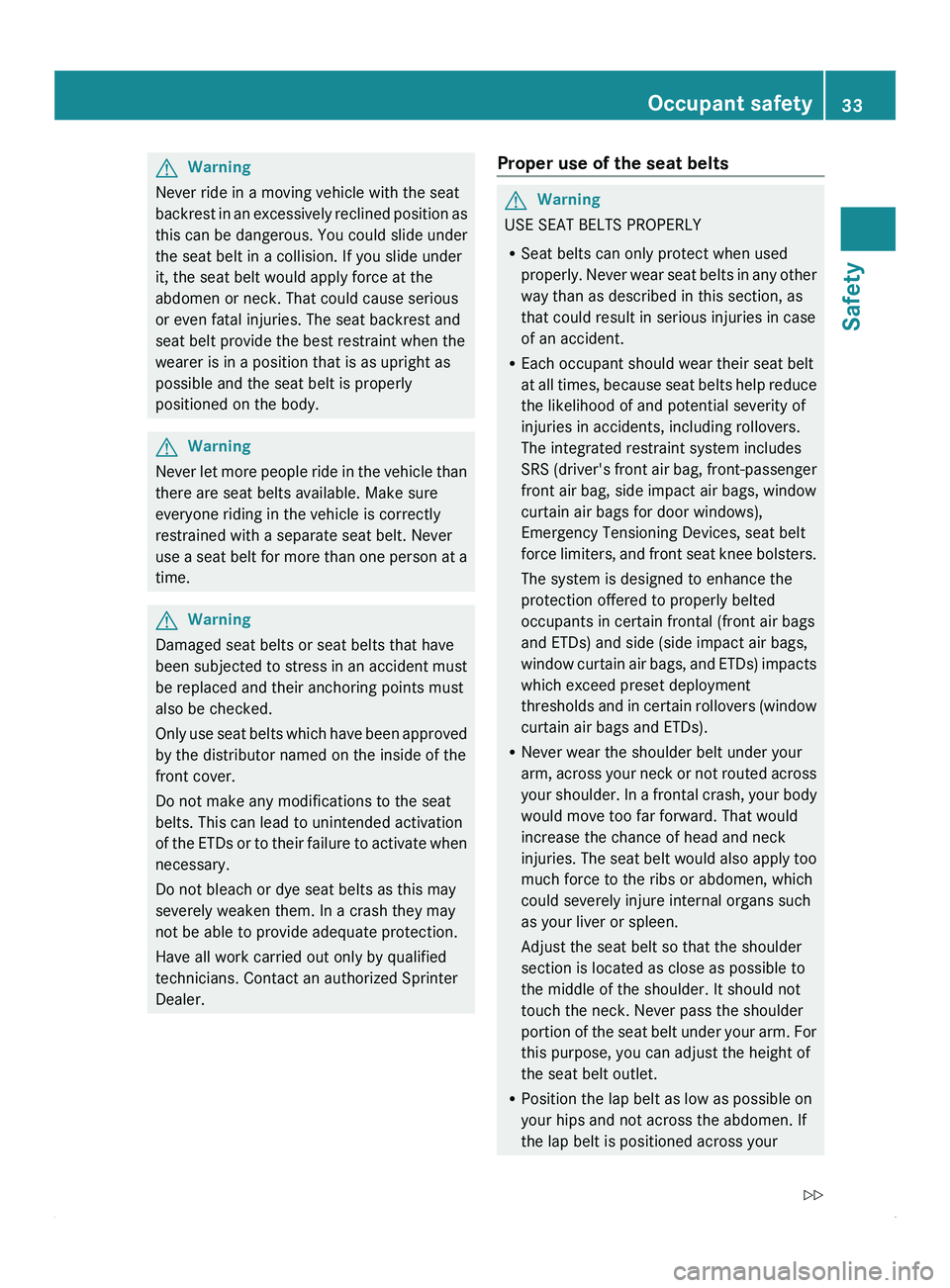
G
Warning
Never ride in a moving vehicle with the seat
backrest in an
excessively reclined position as
this can be dangerous. You could slide under
the seat belt in a collision. If you slide under
it, the seat belt would apply force at the
abdomen or neck. That could cause serious
or even fatal injuries. The seat backrest and
seat belt provide the best restraint when the
wearer is in a position that is as upright as
possible and the seat belt is properly
positioned on the body. G
Warning
Never let
more people ride in the vehicle than
there are seat belts available. Make sure
everyone riding in the vehicle is correctly
restrained with a separate seat belt. Never
use a seat
belt for more than one person at a
time. G
Warning
Damaged seat belts or seat belts that have
been subjected to
stress in an accident must
be replaced and their anchoring points must
also be checked.
Only use seat belts which have been approved
by the distributor named on the inside of the
front cover.
Do not make any modifications to the seat
belts. This can lead to unintended activation
of the ETDs or to their failure to activate when
necessary.
Do not bleach or dye seat belts as this may
severely weaken them. In a crash they may
not be able to provide adequate protection.
Have all work carried out only by qualified
technicians. Contact an authorized Sprinter
Dealer. Proper use of the seat belts G
Warning
USE SEAT BELTS PROPERLY
R Seat belts can only protect when used
properly. Never wear
seat belts in any other
way than as described in this section, as
that could result in serious injuries in case
of an accident.
R Each occupant should wear their seat belt
at all times, because seat belts help reduce
the likelihood of and potential severity of
injuries in accidents, including rollovers.
The integrated restraint system includes
SRS (driver's front air bag, front-passenger
front air bag, side impact air bags, window
curtain air bags for door windows),
Emergency Tensioning Devices, seat belt
force limiters, and front seat knee bolsters.
The system is designed to enhance the
protection offered to properly belted
occupants in certain frontal (front air bags
and ETDs) and side (side impact air bags,
window curtain air bags, and ETDs) impacts
which exceed preset deployment
thresholds and in certain rollovers (window
curtain air bags and ETDs).
R Never wear the shoulder belt under your
arm, across your neck or not routed across
your shoulder. In a frontal crash, your body
would move too far forward. That would
increase the chance of head and neck
injuries. The seat belt would also apply too
much force to the ribs or abdomen, which
could severely injure internal organs such
as your liver or spleen.
Adjust the seat belt so that the shoulder
section is located as close as possible to
the middle of the shoulder. It should not
touch the neck. Never pass the shoulder
portion of the seat belt under your arm. For
this purpose, you can adjust the height of
the seat belt outlet.
R Position the lap belt as low as possible on
your hips and not across the abdomen. If
the lap belt is positioned across your Occupant safety
33
Safety
Z
Page 42 of 292

Driver's front air bag 0046 deploys in front of
the steering wheel; co-driver's front air
bag
0047 deploys in front of and above the glove
box. They are deployed:
R in the event of certain frontal impacts
R if the system determines that air bag
deployment can
offer additional protection
to that provided by the seat belt
R if the respective seat belt is fastened
R independently of other air bags in the
vehicle
If the event of a rollover, the front air bags are
generally not deployed unless the system
detects high vehicle deceleration in a
longitudinal direction.
The air bags will not deploy in impacts which
do not exceed the system's preset
deployment thresholds. You will then be
protected by the seat belt, provided that it is
fastened.
Side impact air bags G
Warning
Observe "Important safety notes"
(Y page 38). G
Warning
If you wish to use seat covers, we recommend
for safety reasons that you use only those
approved for Sprinter vehicles.
The seat covers must feature a special tear
seam for the side impact air bags. The side
impact air bag may otherwise not deploy
correctly and may fail to provide the intended
degree of protection in the event of a collision.
Suitable seat covers can be obtained from any
authorized Sprinter Dealer. G
Warning
The pressure sensors for side impact air bag
control are located in the doors. Do not
modify any components of the doors or door
trim panels including, for example, the
addition of door speakers. Improper repair work on the doors or the
modification or addition of components to the
doors creates a risk of rendering the side
impact air bags inoperative or causing
unintended air bag deployment. Work on the
doors must therefore only be performed by
qualified technicians. Contact an authorized
Sprinter Dealer.
G
Warning
Only use seat covers which have been tested
and approved for your vehicle type by the
distributor named on the inside of the front
cover. Using other seat covers may interfere
with or prevent the deployment of the front
side impact air bags. Contact an authorized
Sprinter Dealer for availability.
When deployed, the side impact air bags offer
additional protection for the thorax of the
vehicle occupants on the side of the vehicle
on which the impact occurs. However, they
do not protect the:
R head
R neck
R arms Side impact air bags
0046
deploy next to the
outer seat cushions.
Side impact air bags 0046 are deployed:
R on the side on which the impact occurs
R at the start of an accident with a high rate
of lateral vehicle deceleration or
acceleration, e.g. in a side impact
R whether or not the seat belt is fastened40
Occupant safety
Safety
Page 43 of 292

R
independently of the front air bags
R independently of the Emergency
Tensioning Devices
The side impact air bags are generally not
deployed in the
event of a rollover, unless the
system detects high vehicle deceleration or
acceleration in a lateral direction and
determines that they can offer additional
protection to that provided by the seat belt.
The side impact air bags are not deployed in
side impacts which do not exceed the
system's deployment threshold.
Window curtain air bags G
Warning
Observe "Important safety notes"
(Y page 38).
The window curtain air bags enhance
protection for the head (but not the chest or
arms) of the
vehicle occupants on the side of
the vehicle on which the impact occurs.
The window curtain air bags are installed in
the side of the roof frame above the front
doors. Window curtain air bags
0046 are deployed:
R on the side on which the impact occurs
R at the start of an accident with a high rate
of lateral vehicle deceleration or
acceleration, e.g. in a side impact
R regardless of whether the co-driver's seat
is occupied
R whether or not the seat belt is fastened R
in the event
of a rollover where the system
determines that air bag deployment can
offer additional protection to that provided
by the seat belt
R independently of the front air bags
R independently of the Emergency
Tensioning Devices
The window curtain air bags will not deploy in
impacts which do not exceed the system's
preset thresholds. You will then be protected
by the seat belt, provided that it is fastened. Children in the vehicle
Important safety notes If an infant or child is traveling in the vehicle:
X
Secure the child using an infant or child
restraint system appropriate
to the age and
weight of the child.
X Make sure that the infant or child is
properly secured at all times while the
vehicle is in motion. G
Warning
When leaving the vehicle, always remove the
key from the
ignition lock. Always take the key
with you and lock the vehicle. Do not leave
children unattended in the vehicle, even if
they are secured in a child restraint system,
or with access to an unlocked vehicle. A
child's unsupervised access to a vehicle could
result in an accident and/or serious personal
injury.
Children could injure themselves on parts of
the vehicle or could suffer severe or fatal
injury due to extreme heat or cold.
If children open a door, they could injure other
persons or get out of the vehicle and injure
themselves or be injured by following traffic.
Do not expose the child restraint system to
direct sunlight. This could cause, for example,
metal parts of the child restraint system to
become very hot. Touching these parts could
cause burns. Occupant safety
41
Safety Z
Page 62 of 292
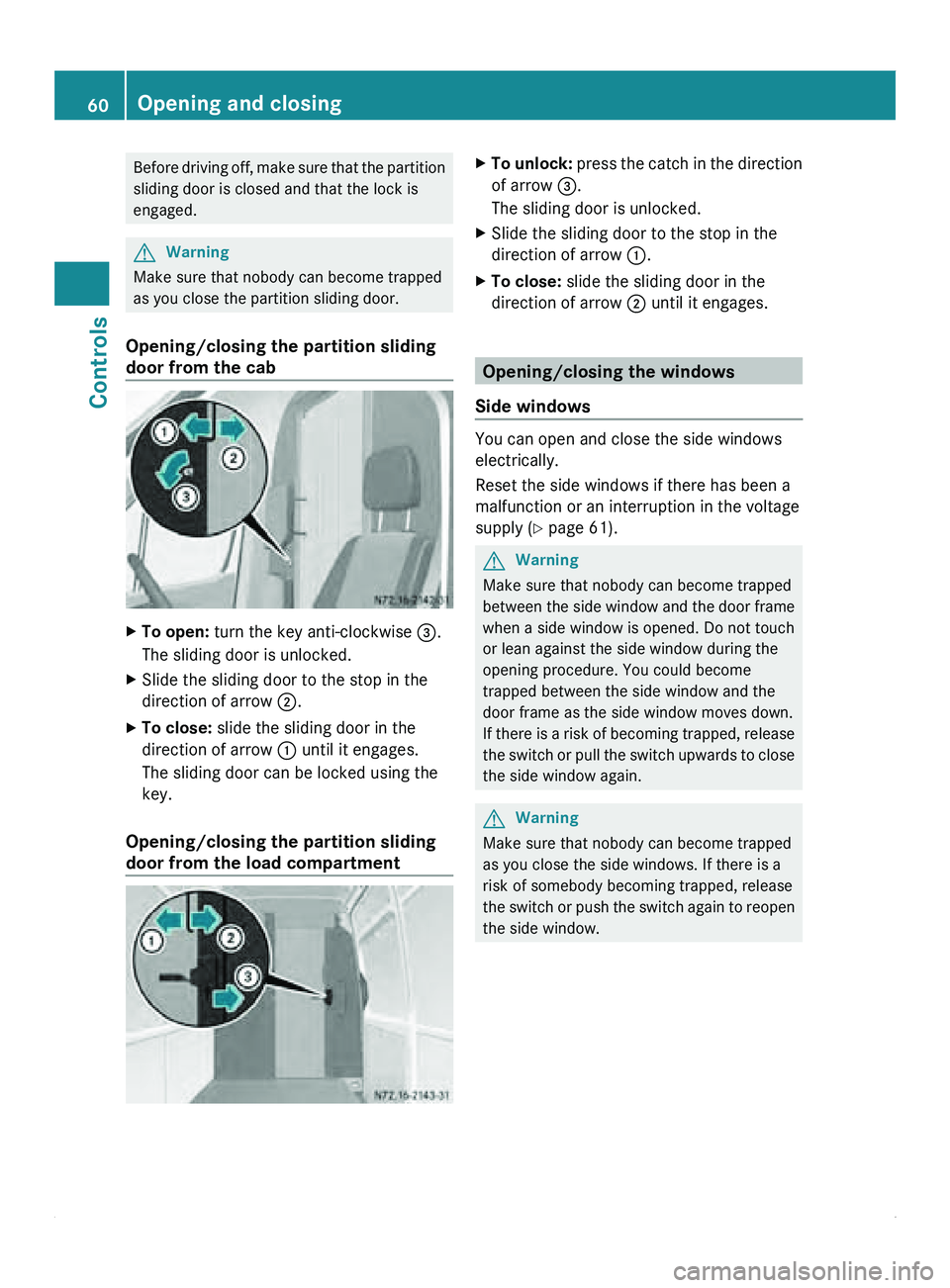
Before driving off, make sure that the partition
sliding door is closed and that the lock is
engaged. G
Warning
Make sure that nobody can become trapped
as you close the partition sliding door.
Opening/closing the partition sliding
door from the cab X
To open: turn the key anti-clockwise 008A.
The sliding door is unlocked.
X Slide the sliding door to the stop in the
direction of arrow 0047
.
X To close: slide the sliding door in the
direction of arrow 0046 until it engages.
The sliding door can be locked using the
key.
Opening/closing the partition sliding
door from the load compartment X
To unlock: press the catch in the direction
of arrow 008A.
The sliding door is unlocked.
X Slide the sliding door to the stop in the
direction of arrow 0046.
X To close: slide the sliding door in the
direction of arrow 0047 until it engages. Opening/closing the windows
Side windows You can open and close the side windows
electrically.
Reset the side windows if there has been a
malfunction or an interruption in the voltage
supply (
Y page 61). G
Warning
Make sure that nobody can become trapped
between the side window and the door frame
when a side window is opened. Do not touch
or lean against the side window during the
opening procedure. You could become
trapped between the side window and the
door frame as the side window moves down.
If there is a risk of becoming trapped, release
the switch or pull the switch upwards to close
the side window again. G
Warning
Make sure that nobody can become trapped
as you close the side windows. If there is a
risk of somebody becoming trapped, release
the switch or push the switch again to reopen
the side window. 60
Opening and closing
Controls
Page 63 of 292

Control panel (example, driver's door)
0046
Power window, left
0047 Power window, right
X Turn the key to position 2 in the ignition
lock.
X To open/close: pull or press switch 0046
or 0047 until the window has reached the
desired position.
If you press the switch beyond the pressure
point and then release it, the window opens
automatically. To stop the movement, press
or pull the switch again. G
Warning
Do not leave children unsupervised in the
vehicle, even if they are secured in a child
restraint system. Children could otherwise
injure themselves on parts of the vehicle.
They could be
severely or even fatally injured
by prolonged exposure to intense heat or
cold.
If children open a door, they could:
R injure other people
R get out of the vehicle and thereby injure
themselves or be injured by a passing
vehicle
R severely injure themselves by falling down,
in particular due to the vehicle height
Always take the key with you when leaving the
vehicle, even if you are only leaving for a short
time. Resetting the side windows
Reset the side windows if there has been a
malfunction or an interruption in the voltage
supply.
X
Pull the two power window switches and
hold for approximately one second after
closing the side window. Anti-theft systems
Immobilizer
The immobilizer prevents the vehicle from
being started without the correct key.
When leaving the
vehicle, always take the key
with you and lock the vehicle. The engine can
be started by anyone if the key is left inside
the vehicle.
X To activate: remove the key from the
ignition lock.
X To deactivate: insert the key into the
ignition lock and turn to position 2.
i The immobilizer is always deactivated
when you start the engine.
In the event that the engine cannot be
started when the starter battery is fully
charged, the immobilizer
may be defective.
Contact an authorized Sprinter Dealer or
call 1-877-762-8267 (USA) or
1-800-387-0100 (Canada). Anti-theft alarm system (ATA)
If the alarm system is armed, a visual and
audible alarm is
triggered when the following
are opened:
R a door
R the hood
The alarm is not switched off, even if you
close the open door that triggered it, for
example. Anti-theft systems
61
Controls Z
Page 72 of 292
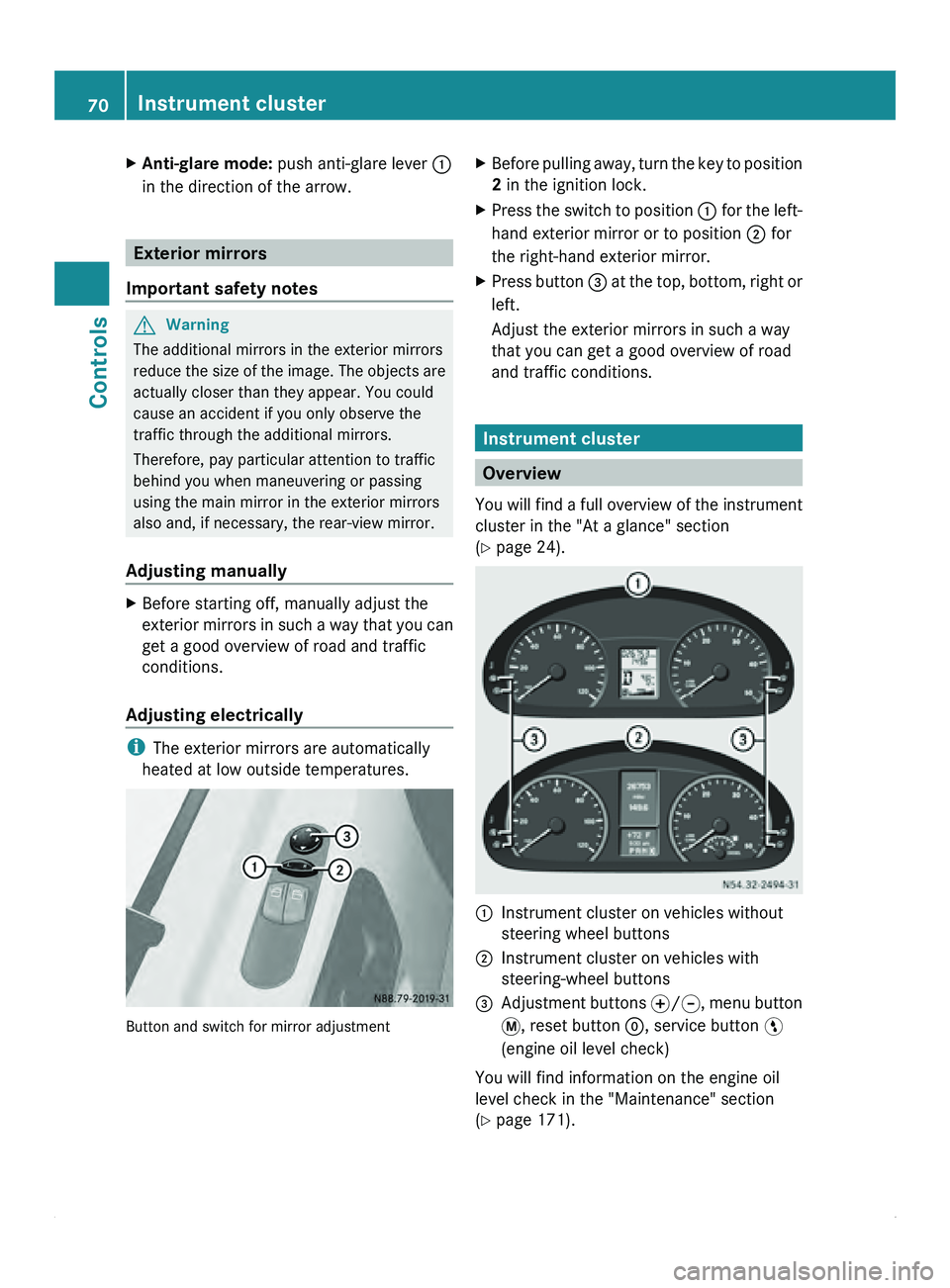
X
Anti-glare mode: push anti-glare lever 0046
in the direction of the arrow. Exterior mirrors
Important safety notes G
Warning
The additional mirrors in the exterior mirrors
reduce the size
of the image. The objects are
actually closer than they appear. You could
cause an accident if you only observe the
traffic through the additional mirrors.
Therefore, pay particular attention to traffic
behind you when maneuvering or passing
using the main mirror in the exterior mirrors
also and, if necessary, the rear-view mirror.
Adjusting manually X
Before starting off, manually adjust the
exterior mirrors in
such a way that you can
get a good overview of road and traffic
conditions.
Adjusting electrically i
The exterior mirrors are automatically
heated at low outside temperatures. Button and switch for mirror adjustment X
Before pulling away, turn the key to position
2 in the ignition lock.
X Press the switch to position 0046 for the
left-
hand exterior mirror or to position 0047 for
the right-hand exterior mirror.
X Press button 008A at
the
top, bottom, right or
left.
Adjust the exterior mirrors in such a way
that you can get a good overview of road
and traffic conditions. Instrument cluster
Overview
You will find
a full overview of the instrument
cluster in the "At a glance" section
(Y page 24). 0046
Instrument cluster on vehicles without
steering wheel buttons
0047 Instrument cluster on vehicles with
steering-wheel buttons
008A Adjustment buttons 0069/006A, menu button
007B
, reset button 0048, service button 00A4
(engine oil level check)
You will find information on the engine oil
level check in the "Maintenance" section
(Y page 171). 70
Instrument cluster
Controls
Page 73 of 292
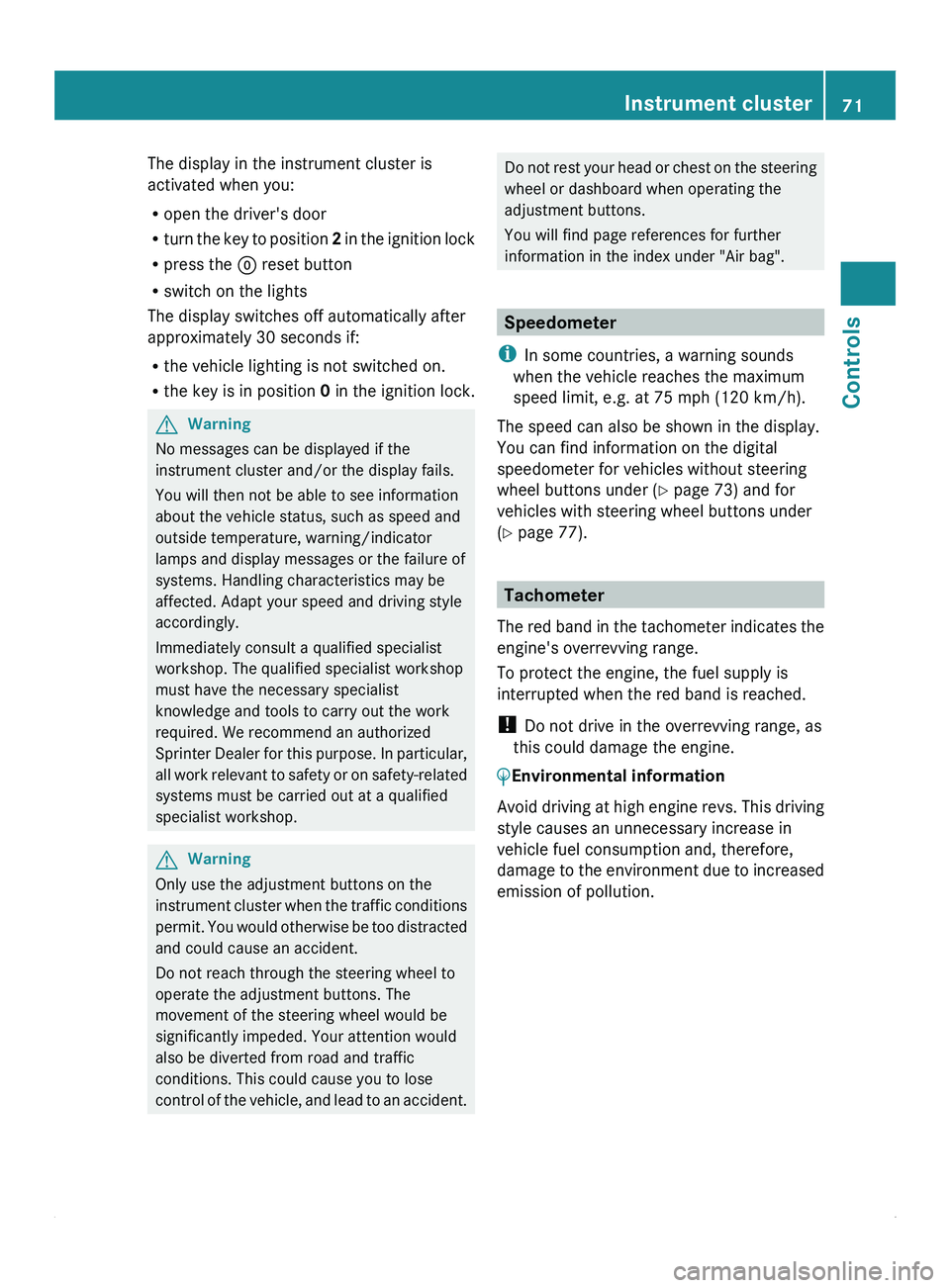
The display in the instrument cluster is
activated when you:
R
open the driver's door
R turn the key
to position 2 in the ignition lock
R press the 0048 reset button
R switch on the lights
The display switches off automatically after
approximately 30 seconds if:
R the vehicle lighting is not switched on.
R the key is in position 0 in the ignition lock.G
Warning
No messages can be displayed if the
instrument cluster and/or the display fails.
You will then not be able to see information
about the vehicle status, such as speed and
outside temperature, warning/indicator
lamps and display messages or the failure of
systems. Handling characteristics may be
affected. Adapt your speed and driving style
accordingly.
Immediately consult a qualified specialist
workshop. The qualified specialist workshop
must have the necessary specialist
knowledge and tools to carry out the work
required. We recommend an authorized
Sprinter Dealer for
this purpose. In particular,
all work relevant to safety or on safety-related
systems must be carried out at a qualified
specialist workshop. G
Warning
Only use the adjustment buttons on the
instrument cluster when
the traffic conditions
permit. You would otherwise be too distracted
and could cause an accident.
Do not reach through the steering wheel to
operate the adjustment buttons. The
movement of the steering wheel would be
significantly impeded. Your attention would
also be diverted from road and traffic
conditions. This could cause you to lose
control of the vehicle, and lead to an accident. Do not rest your head or chest on the steering
wheel or dashboard when operating the
adjustment buttons.
You will find page references for further
information in the index under "Air bag".
Speedometer
i In some countries, a warning sounds
when the vehicle reaches the maximum
speed limit, e.g. at 75 mph (120 km/h).
The speed can also be shown in the display.
You can find information on the digital
speedometer for vehicles without steering
wheel buttons under ( Y page 73) and for
vehicles with steering wheel buttons under
(Y page 77). Tachometer
The red band
in the tachometer indicates the
engine's overrevving range.
To protect the engine, the fuel supply is
interrupted when the red band is reached.
! Do not drive in the overrevving range, as
this could damage the engine.
0040Environmental information
Avoid driving at high engine revs. This driving
style causes an unnecessary increase in
vehicle fuel consumption and, therefore,
damage to the
environment due to increased
emission of pollution. Instrument cluster
71
Controls Z